loading...
Roasting a turkey has always intimidated and disarmed me.
Turkeys are one of the largest animals we ever cook and their size can lead not only to demanding time spent slaving in the kitchen, but also impossible hiccups in the way the final product turns out. Whether you’re roasting a 10 lb. bird or a 20 lb. bird, the potential for missteps is pretty high. My mother always made roasting a turkey look effortless and graceful, as if she was born to dress, baste, and cook her way through the world with a perfect turkey in front of her.
But the process is much more scientific than other kinds of cooking (not including baking, of course) and demands that you know your oven’s quirks and kinks as well as how to keep a quality bird moist and flavorful without drying out in the oven.
In my Monday post, I detailed my admiration of Carol Dorsey’s moist and flavorful roasted bird. In the past few years, I’ve typically turned to frying a turkey because of how quick and rewarding the results can be. In fact, I never thought I’d see the day I’d want to roast a bird again and considered myself a bit of a peanut-oil/turkey-frying purist until last week. But Carol’s turkey was so good, I just had to give a basic roast another try.Intimidation aside, I turned to some fellow chefs on my Facebook page for what makes an excellent turkey. The result? Several easy tips that I think everyone should know:
1.) Brine the bird. This step has been traditionally omitted by one of my aunts, and although I will never name names (the injustice!), I have experienced more than one Thanksgiving in the past ten years that featured a pretty dry and sad bird. Nothing’s worse than trying to figure out a way to clean your plate without choking….
2.) Roast turkey breast-side down. This idea is fairly new to me, but it makes complete sense: by roasting your turkey breast-side down, the juices are forced to run into the meatiest part of the bird and not evaporate or run off in the oven. This is another great technique for avoiding a bird that’s too dry.
3.) Temperature, temperature, temperature. Start with a high temperature for a quick burst of heat (usually 450F or 500F for 30 minutes) and then drop the temperature down to a lower, more stable degree setting for a short amount of time. The days of 4- and 5-hour roasts are behind me. Now, one can roast a turkey within 3 hours by using this technique.
4.) Stuff cavity with seasonal and flavorful aromatics. As a child, my New England aunts still stuffed their bird with bread-like stuffing that tasted great, but was a little bit dangerous to eat (something we know now–by the time the stuffing is safe to eat, the turkey is overcooked). Although I love the image of a bird bursting with stuffing, one of the problems with this step is how the bread pulls moisture away from the meat and into its cavity (which means – dry bird, but deliciously moist stuffing). Today, several of my friends have pointed out the perks of citrus season in south Louisiana. We can stuff our birds with Meyer lemons (as I do here), or even include satsumas, kumquats, you name it. Citrus adds beautiful flavor to the bird along with onions, winter herbs, and root vegetables.
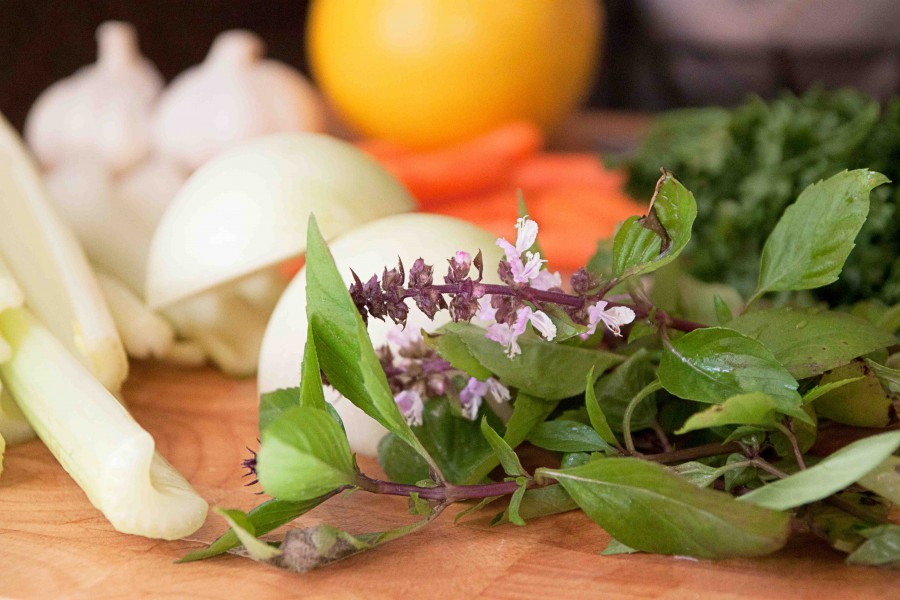
Pictured: The mise en scéne of roasting a bird: root vegetables, seasonal citrus, and robust aromatics.
With these few tips, roasting a turkey is a much more systematized–but successful–process that even newbies to Thanksgiving dinner can accomplish. My final results for a 15 lb. bird were so startlingly delicious, I couldn’t believe the turkey was roasted instead of fried…and I made it. For a simple roast bird without the intimidation, try these steps for improving an old favorite recipe.
Roast Turkey
Yield: 12-15 servings
Calories: 129.6 per serving (see here for full nutritional information)
Prep Time: 20 minutes (minus thaw time)
Cook Time: 3-4 hours
This recipe is adapted from Alton Brown’s classic roasted turkey recipe at Food Network (here). I’ve followed Brown’s methods in brining and roasting the bird, but added several ingredients to the brine and aromatic stuffing ingredients for the roast. For other helpful posts on the breast-side down technique, see Elise Bauer’s recipe for her mother’s roast turkey (here); for turkey roasting 101 in all of its details, see here.
Ingredients:
*1 (14-15 lb.) turkey, thawed ahead of time
—Brine—
*1 cup kosher salt (or, 1 1/2-2 cups table salt)
*1/2 cup dark brown sugar
*1 gallon vegetable stock (I used 16-ounces chicken stock plus enough water to cover the bird (about 2/3 of a gallon))
*1 tablespoon black peppercorns
*1 1/2 teaspoons allspice
*1 (2-inch) piece of ginger, sliced into circular rounds (about 1/2 inch thick)
*1 Meyer lemon, halved
*1 gallon ice water
—Stuffing/Aromatics—
*1 green apple, sliced
*1 onion, halved
*1 tablespoon cinnamon
*3 star anises
*1 cup water
*1/2 cup basil, packed and roughly chopped
*1/2 cup parsley, roughly chopped
*4 celery ribs
*1 cup baby carrots
*1 onion, halved
*1 Meyer lemon, halved
*pepper, for rub
*olive oil, for rub
SPECIAL EQUIPMENT NEEDED:
*pan with roasting rack and trussing string
1.) Thaw turkey based on package instructions. The night before you plan to roast the bird, prepare your brine: Bring the salt, brown sugar, vegetable stock (and necessary water), peppercorns, allspice, ginger, and lemon to a boil in a large pot stirring occasionally. Remove from heat and cool.
2.) Assemble brine: Transfer infusion to 5-gallon bucket (or like receptacle) with ice water. Place turkey in brine (with innards removed) breast-side down, immerse, and cover. Refrigerate overnight for at least 8 hours but up to 16. (Note: in his episode for Good Eats, Brown weighs down the bird with a small bag of ice. I used a heavy (coated) cast-iron lid.)
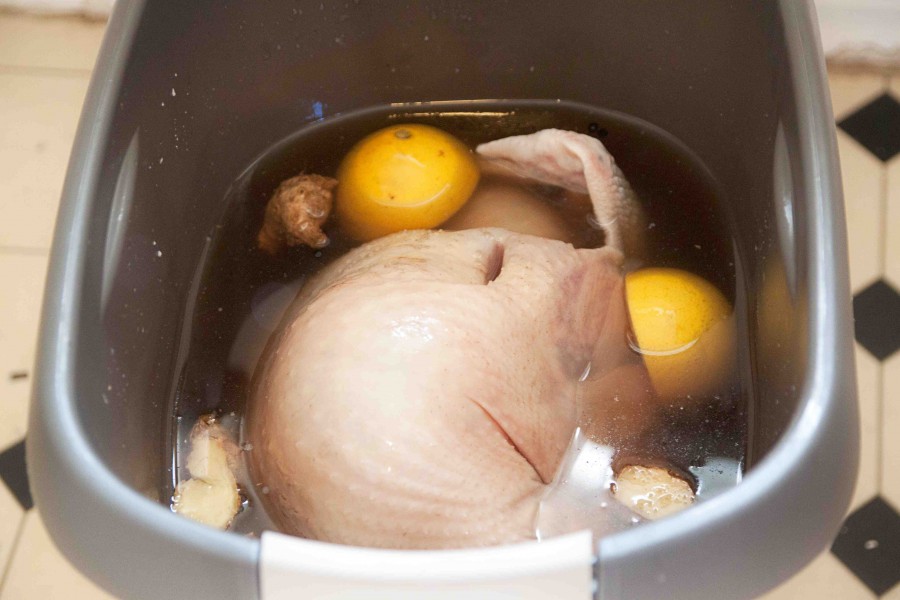
3.) Prepare bird for roast: Preheat oven to 500F and setup pan with roasting rack. Remove turkey from brine and transfer to rack. Pat turkey dry all around. Meanwhile, assemble your mise en scéne–aromatics plus extra carrots, onion, and celery ribs.
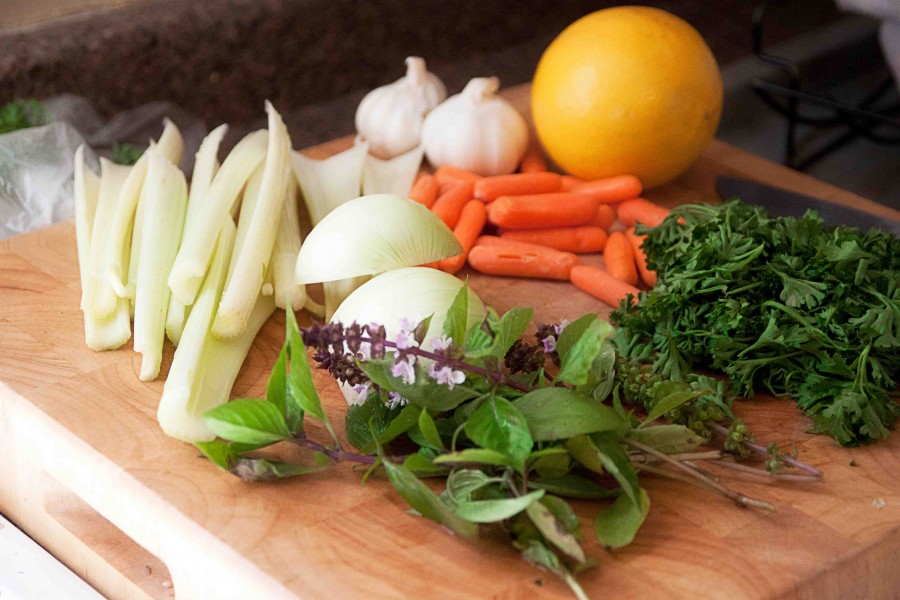
4.) Prepare aromatics/stuffing: Combine first seven ingredients in a bowl, stir to combine, and microwave for five minutes on high to infuse and steep. While aromatics are microwaving, stuff turkey with next four ingredients. When aromatics are done, pour into the bird’s cavity.
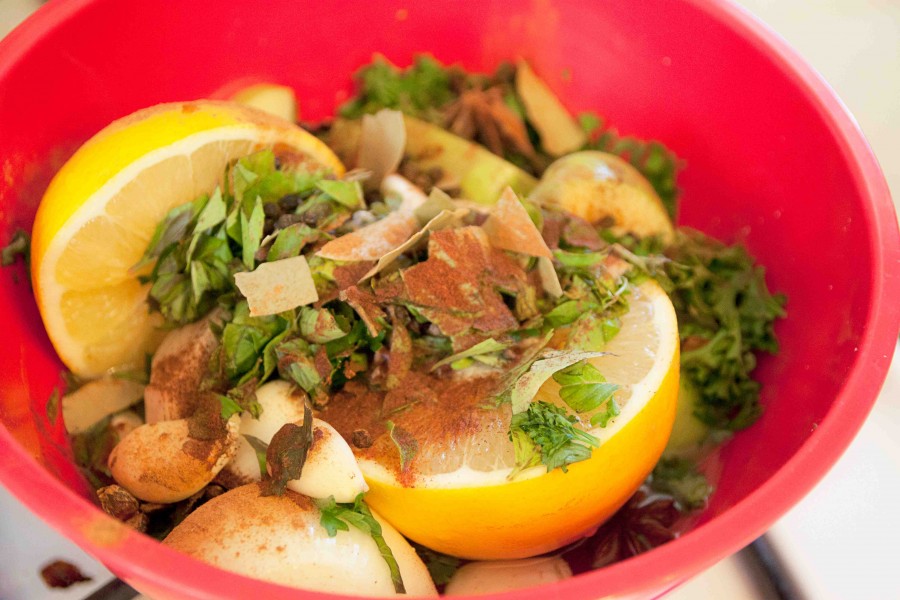
5.) Cover cavity with aluminum foil and wrap legs tightly with trussing string.
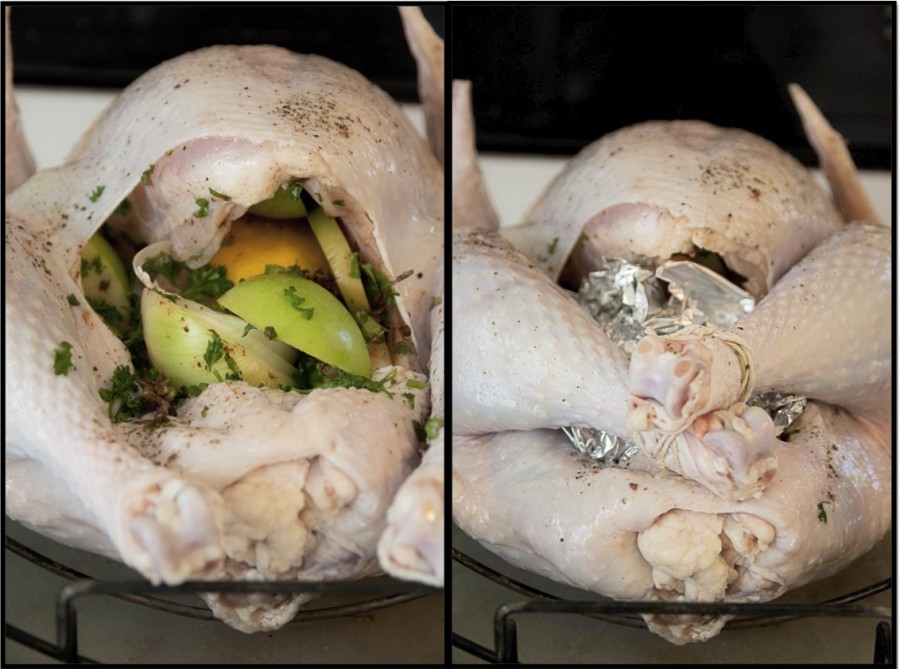
6.) Pepper bird all over and drizzle with olive oil. Rub pepper and oil into the skin. Flip bird onto its breast and roast breast-side down.
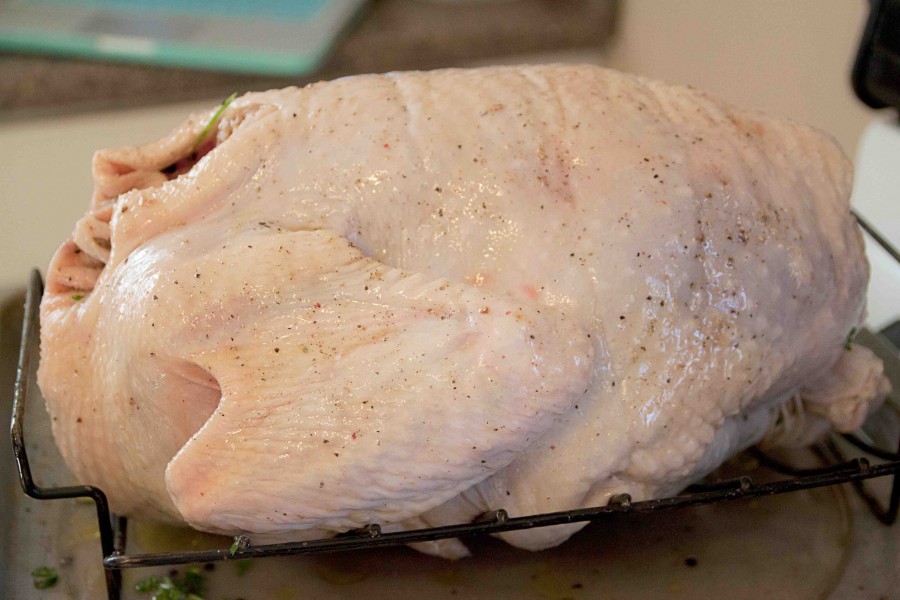
7.) Roast bird for 30 minutes at 500F. Drop heat down to 350F and roast bird until a thermometer reads 161F at the thickest part of the breast (about 2 to 2 1/2 hours, or see this guide at butterball for all of your cooking time and calculating needs). Rotate bird to its back 45 minutes to 1 hour before removing from oven to brown the breast thoroughly.
8.) Remove done bird from oven and rest for 15 minutes before carving. Makes 12-15 servings.
—
Follow me on Pinterest: http://pinterest.com/helana/
Twitter: https://twitter.com/DancesWLobsters
Facebook: https://www.facebook.com/pages/Clearly-Delicious/103136413059101

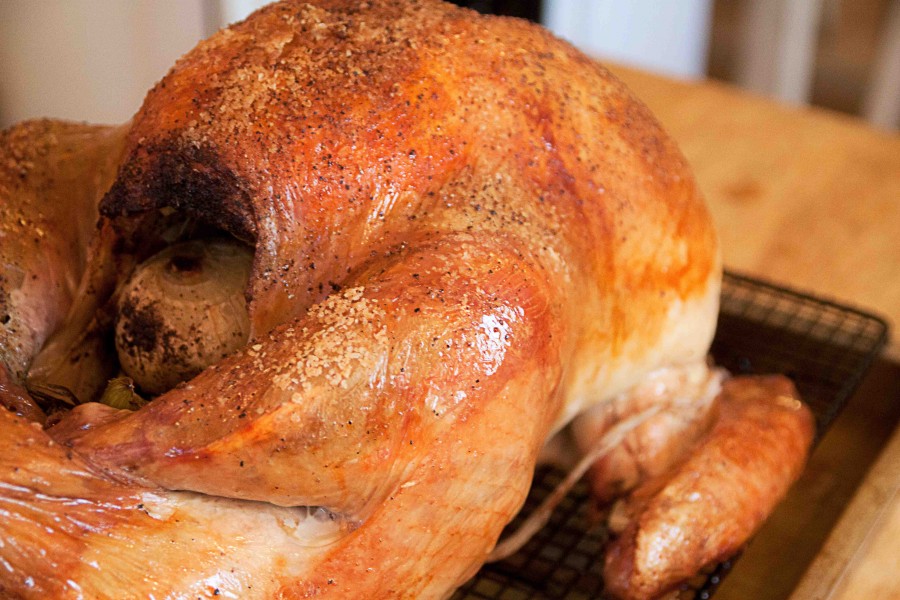
4 Comments
Russ Turley
November 28, 2012 at 7:25 pmI now need to roast another turkey.
Clearly Delicious » Smashed Cauliflower
November 30, 2012 at 7:03 am[…] « […]
Clearly Delicious » Carol’s Gumbo
December 26, 2012 at 2:26 pm[…] « » […]
Clearly Delicious » Prep School 101: Chopping
January 7, 2013 at 7:01 am[…] was really quite simple: when “roughly chopping” a bunch of parsley (as in this recipe here), how much was enough? And, when did a rough chop become a basic chop? What if she over-chopped her […]